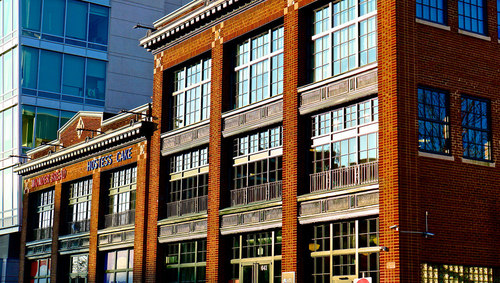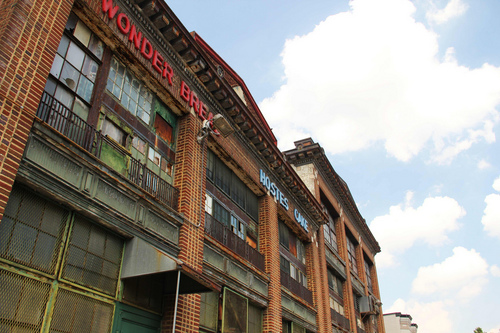Building of the Week: The Wonder Bread Factory
If you walk down S Street in Shaw, you’ll pass the Wonder Bread Factory between 7th and 6th Streets NW. Though its façade still boasts “Wonder Bread” and “Hostess Cake,” today the building is full of retail space and offices. It’s a great example of adaptive reuse, which is repurposing a historic building for a new function.
The oldest portion of the 641 S Street NW property dates to 1913. The building was an expansion of Dorsch’s White Cross Bakery. Wonder Bread acquired the company and its property in 1936, and may have used the space principally to bake Hostess Cake products.
While many longtime Washingtonians remember the delicious smell the factory emitted, Wonder Bread moved its operations in the 1980s, closing the factory. The building’s ensuing vacancy hastened its decline, and by the time Douglas Development Corporation bought the property in 1997, collapsed roofing and structural instability were part of the package. There was widespread rust, buckling floorboards, and a patina of general neglect.
The building was— and still is— full of fascinating architectural features.
One of the most distinctive is the white crosses that festoon the original three story brick building. According the Douglas Development’s website, these “were meant to relieve fears that their bread might not be safe to eat after Upton Sinclair’s The Jungle struck fear into people that factory food was unsanitary.”
Other appealing features include the Wonder Bread sign and large multi-pane windows in the front of the building.
Attention also went into restoring finer details of the landmarked building. Open bar joists, which are triangulated lightweight steel trusses, were used to support floors, instead of simpler but anachronistic concrete decks.
Douglas considered a number of uses for over a decade after it bought the building in 1997, including a boutique hotel and apartment complex. In 2010, a mixed use development with retail on the first and second floors and offices on the upper floors prevailed.
Building rehabilitation went on between 2012 and 2013, and which meant a number of changes to the structure. Those included the addition of a fourth story to the factory’s rear, excavation on the S Street side of the building, and a basement excavation, which created space for underground parking. A rooftop terrace also went in, and while much of the building had to be stripped to its hardy skeleton, the open spaces that characterize its original industrial use were retained.
All of these amenities attracted new tenants, like WeWorkDC, Event Space DC, and Youth for Understanding USA. When iStrategyLabss signed a lease in 2014, the building was 100 percent occupied.
It may have taken a while to turn the Wonder Bread factory into a new building, but today’s tenants are clearly proud of their spaces. WeWork devotes an entire paragraph to describing the history and renovation of the building on the location’s webpage.
More broadly, while the tech industry tends to be a forward-thinking one, it clearly finds value in historic places. At its peak, web-based coupon service LivingSocial boasted six offices in Washington, many in adaptively reused or renovated buildings. Also, Twitter’s San Francisco operations are headquartered in an old furniture mart, and AirBnb renovated a warehouse nearby.
Adaptive reuse is also useful in difficult or expensive construction markets. While Washington lacks San Francisco’s zoning nightmare, rehabilitating a building still has financial incentives here. These come principally in the form of Historic Preservation Tax Credits. This federal program grants certain buildings that are listed on the National Register 10 or 20 percent tax credits for reusing a structure based on the Secretary of the Interior’s standards.
The Wonder Bread Factory is an example of an architectural gem successfully repurposed for 21st century economic needs and philosophical desires.



